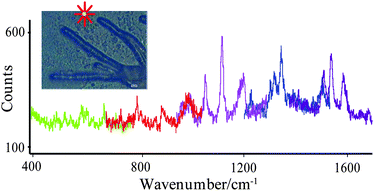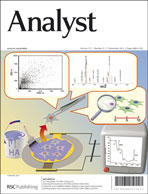High spatial resolution methods to assess the physiology of growing cells should permit analysis of fungal biochemical composition. Whole colony methods cannot capture the details of physiology and organism–environment interaction, in part because the structure, function and composition of fungal hyphae vary within individual cells depending on their distance from the growing apex. Surface Enhanced Raman Scattering (SERS) can provide chemical information on materials that are in close contact with appropriate metal substrates, such as nanopatterned gold surfaces and gold nanoparticles (AuNPs). Since nanoparticles can be generated by living cells, we have created conditions for AuNP formation within and on the surface of Aspergillus nidulans hyphae in order to explore their potential for SERS analysis. AuNP distribution and composition have been assessed by UV-Vis spectroscopy, fluorescence light microscopy, transmission electron microscopy, and scanning transmission X-ray microscopy. AuNPs were often associated with hyphal walls, both in the peripheral cytoplasm and on the outer wall surface. Interpretation of SERS spectra is challenging, and will require validation for the diversity of organic molecules present. Here, we show proof-of-principle that it is possible to generate SERS spectra from nanoparticles grown in situ by living hyphae.

You have access to this article
 Please wait while we load your content...
Something went wrong. Try again?
Please wait while we load your content...
Something went wrong. Try again?


 Please wait while we load your content...
Please wait while we load your content...